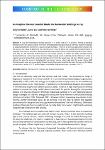An Adaptive Thermal Comfort Model for Residential Buildings in Iraq
| dc.contributor.author | Al-Hafith, O | |
| dc.contributor.author | B.K., S | |
| dc.contributor.author | de Wilde, P | |
| dc.date.accessioned | 2024-04-09T11:14:40Z | |
| dc.date.available | 2024-04-09T11:14:40Z | |
| dc.date.issued | 2019-04-11 | |
| dc.identifier.uri | https://pearl.plymouth.ac.uk/handle/10026.1/22260 | |
| dc.description.abstract |
In Iraq, the temperature reaches around 0 °C in winter and 50 °C in summer. Aiming at providing thermal comfort for people, studies have been advocating developing innovative thermally responsive designs or adopting traditional architecture’s passive design strategies. However, to develop appropriate solutions for the country, it is critical to determine the thermal comfort limits to define the targeted thermal performance of buildings. This research worked on defining Iraqis’ thermal comfort limits in residential buildings for two reasons. First, they are the dominant building type in the country. Second, to inform the design of large housing developments Iraq is planning to have to satisfy large housing needs. Exploring previous literature in Iraq or regional countries shows that residential thermal comfort limits for people have not been defined properly. To achieve this aim, the research conducted thermal comfort survey in four Iraqi cities for a year. Nearly 4800 thermal comfort votes were recorded by 90 participants. The results show that the lower thermal comfort Globe temperature in winter is 17 °C and the highest acceptable Globe temperature in summer is 33 °C. | |
| dc.publisher | Ecohouse Initiative | |
| dc.title | An Adaptive Thermal Comfort Model for Residential Buildings in Iraq | |
| dc.type | conference | |
| plymouth.date-start | 2019-04-10 | |
| plymouth.date-finish | 2019-04-11 | |
| plymouth.publisher-url | https://comfortattheextremes.com/ | |
| plymouth.conference-name | Comfort at the Extremes: Energy, Economy and Climate 2019 | |
| plymouth.journal | https://windsorconference.com/wp-content/uploads/2019/04/CATE2019_Proceedings_v3_web.pdf | |
| plymouth.organisational-group | |Plymouth | |
| plymouth.organisational-group | |Plymouth|Faculty of Arts, Humanities and Business | |
| plymouth.organisational-group | |Plymouth|Faculty of Arts, Humanities and Business|School of Art, Design and Architecture | |
| plymouth.organisational-group | |Plymouth|REF 2021 Researchers by UoA | |
| plymouth.organisational-group | |Plymouth|Users by role | |
| plymouth.organisational-group | |Plymouth|Users by role|Current Academic staff | |
| plymouth.organisational-group | |Plymouth|REF 2021 Researchers by UoA|UoA13 Architecture, Built Environment and Planning | |
| plymouth.organisational-group | |Plymouth|REF 2029 Researchers by UoA | |
| plymouth.organisational-group | |Plymouth|REF 2029 Researchers by UoA|UoA13 Architecture, Built Environment and Planning | |
| dcterms.dateAccepted | 2019-04-02 | |
| dc.date.updated | 2024-04-09T11:14:39Z | |
| dc.rights.embargodate | 2024-4-11 |


